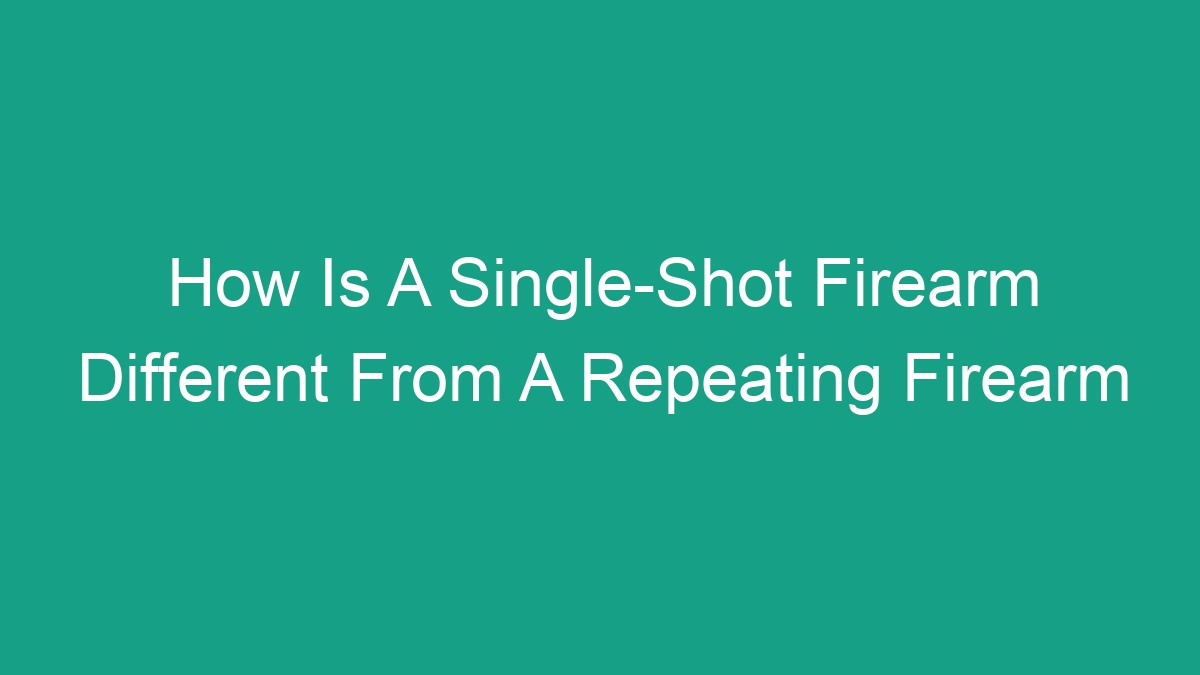
When it comes to firearms, there are various types, each with its own unique characteristics and purposes. However, one of the fundamental distinctions is the difference between single-shot firearms and repeating firearms. Understanding the differences between the two can help enthusiasts and gun owners make informed decisions about the type of firearm that best suits their needs. In this article, we will delve into the key differences between single-shot firearms and repeating firearms, exploring their mechanisms, advantages, and applications.
Single-Shot Firearms
Single-shot firearms, as the name suggests, are designed to hold and discharge only a single round of ammunition at a time. Once the round is fired, the firearm must be manually reloaded before it can be fired again. This reloading process typically involves opening the action, removing the spent casing, inserting a new round, and closing the action. Single-shot firearms come in various forms, including rifles, shotguns, and pistols.
Advantages of single-shot firearms:
- Simple and easy to operate
- Reliable and less complex mechanisms
- Well-suited for training and teaching firearm handling and marksmanship
- Can be more affordable compared to repeating firearms
- Lighter weight and more compact for easy carrying and storage
Repeating Firearms
In contrast, repeating firearms are capable of holding multiple rounds of ammunition and firing them sequentially without the need for manual reloading after each shot. There are different types of repeating firearms, including bolt-action rifles, semi-automatic pistols, and pump-action shotguns. The capability to fire multiple rounds without manual intervention makes repeating firearms popular for various applications, including self-defense, hunting, and competitive shooting.
Advantages of repeating firearms:
- Higher rate of fire due to the ability to hold and fire multiple rounds
- Increased ammunition capacity for extended shooting sessions
- Greater versatility and adaptability for different shooting scenarios
- Efficient for self-defense and tactical use
- Commonly used by law enforcement and military personnel
Key Differences
The primary differences between single-shot firearms and repeating firearms lie in their operational mechanisms and practical applications. Understanding these distinctions can help individuals make informed choices when selecting a firearm for a specific purpose. Here are the key differences:
| Aspect | Single-Shot Firearms | Repeating Firearms |
|---|---|---|
| Firearm Action | Single action – requires manual reloading after each shot | Varies based on firearm type (e.g., semi-automatic, bolt-action, pump-action) with mechanisms to hold and fire multiple rounds |
| Rate of Fire | Slow due to manual reloading process | Higher rate of fire due to the ability to hold and fire multiple rounds |
| Ammunition Capacity | Limited to a single round | Capable of holding multiple rounds for continuous firing |
| Practical Applications | Ideal for training, marksmanship practice, and specialized hunting scenarios | Versatile for self-defense, hunting, competitive shooting, and military/law enforcement use |
It’s essential to consider the intended use and specific requirements when choosing between single-shot firearms and repeating firearms. For example, individuals interested in precision shooting or teaching firearm safety may lean towards single-shot firearms, while those focusing on rapid and continuous shooting may opt for repeating firearms.
Additionally, legal regulations and restrictions may influence the selection of firearms, as certain jurisdictions impose limitations on the use and ownership of repeating firearms based on their capabilities and intended purposes.
Conclusion
In summary, single-shot firearms and repeating firearms serve distinct purposes and offer unique advantages based on their operational mechanisms and practical applications. Whether it’s for recreational shooting, competitive sports, hunting, or personal protection, individuals should carefully evaluate their needs and preferences to select the most suitable firearm type.
By understanding the differences between single-shot firearms and repeating firearms, individuals can make informed decisions that align with their intended use, while also ensuring compliance with relevant laws and regulations. With proper knowledge and consideration, firearm enthusiasts and gun owners can maximize their shooting experiences and uphold responsible firearm ownership.



